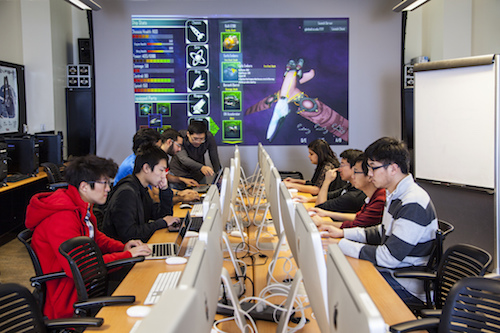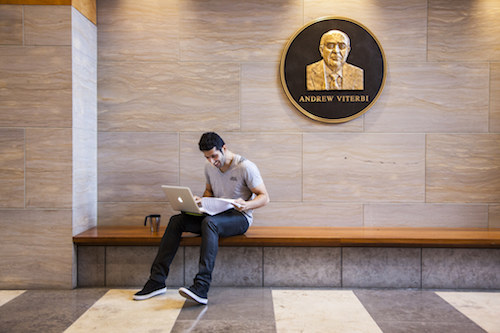
Using GPU-enabled VDI from Dell, USC’s Viterbi School of Engineering designed its computer classrooms to handle graphics-intensive applications. Image Courtesy of USC Viterbi School of Engineering
Latest News
April 12, 2016
Leave it to millennials to raise expectations, even for their engineering environments.
At the University of Southern California’s (USC) Viterbi School of Engineering, students’ desire to access graphically intensive applications like CAD and data visualization software whenever and wherever they might be working set in play a major IT transformation. The highly ranked school migrated from a traditional desktop and workstation-based computer and engineering lab to a virtual desktop infrastructure (VDI) set up, with the goal of giving students the flexibility to access assignments and collaborate on engineering projects from any location, using their preferred devices, including smartphones and tablets.
 Students expect to be able to access their graphics-rich engineering applications any time and in any location. Image Courtesy of USC Viterbi School of Engineering
Students expect to be able to access their graphics-rich engineering applications any time and in any location. Image Courtesy of USC Viterbi School of EngineeringThe school is now employing NVIDIA vGPU-enhanced virtual desktops and Wyse thin client endpoints to allow multiple users to share virtual GPU hardware acceleration for engineering applications without compromising the graphics experience, according to Michael Goay, executive director of Information Technology, for the USC engineering school, which enrolls 6,300 students in addition to another 1,700 non-engineering students.
“Over the past few years, the school has received high enrollments in classes that require graphically intensive applications such as 3D CAD, 3D CGI animation, data visualization and GIS,” said Goay. “In addition, the school found that incoming engineering students have a high level of competence in IT and higher expectations for the IT they use within the program. We needed a highly flexible, cost effective and scalable solution to support computer classrooms and to extend access to graphically intensive engineering applications for students outside of classrooms.”
In the past, engineering applications have typically not been a good fit for VDI because they require more robust graphics acceleration technology. The combination of the NVIDIA vGPU-enhanced virtual desktops and Wyse thin client endpoints, coupled with Dell PowerEdge R720 servers and Teradici’s APEX PCoIP offload cards, provided a platform that addressed many of traditional VDI’s limitations for graphics-intensive engineering programs, Goay explained.
Today, USC engineering students can study and do work in engineering programs such as CAD, CFD, FEM, and other simulation applications in any location where they feel inclined, including on their own devices. “Student devices often don’t have the requisite horsepower to run their required applications, especially those that render or necessitate higher-end graphics,” he said, adding that students no longer have to visit a physical computer lab to gain access to the tools they need to complete an assignment.
By housing virtual desktops and user data in the data center, thanks to VDI, student users also benefit from enhanced performance, better collaboration, and improved security resulting from a regular backup schedule that most don’t practice along with tighter access controls.
 Using GPU-enabled VDI from Dell, USC’s Viterbi School of Engineering designed its computer classrooms to handle graphics-intensive applications. Image Courtesy of USC Viterbi School of Engineering
Using GPU-enabled VDI from Dell, USC’s Viterbi School of Engineering designed its computer classrooms to handle graphics-intensive applications. Image Courtesy of USC Viterbi School of EngineeringEven better, Goay said students no longer need to invest or have access to workstation-class computers to run these sophisticated engineering programs. “Because the client device runs a simple VDI client program to connect to the appropriate GPU-optimized virtual desktop, it levels the playing field and works to bridge the so-called digital divide,” Goay said.
The video below discusses how VDI technologies are enabling graphics-intensive engineering applications to run optimally in a virtualized environment.
Subscribe to our FREE magazine, FREE email newsletters or both!
Latest News
About the Author
Beth Stackpole is a contributing editor to Digital Engineering. Send e-mail about this article to [email protected].
Follow DE





